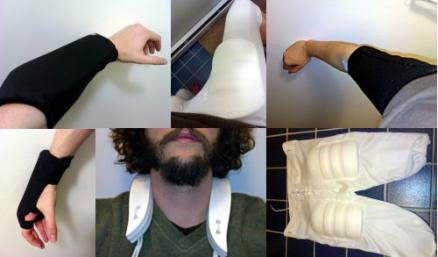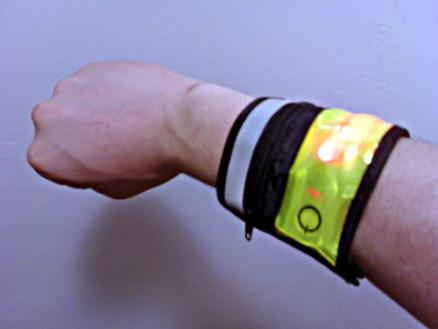Comfort, Wearables, and a Peripersonal Space Experiment
I've been doing a lot of work on anthropometrics, and I found the articles for this week to be really helpful for my thesis research. I have been thinking about how to measure vital signs on a patient's body in a way that is inexpensive, accurate, and user-friendly, both for the patient and the technician. Equally important, however, is that a measuring device should be wearable, by the authors' definitions, if only for a short time.
In "The Comfort Assessment of Wearable Computers," by James Knight, et al., the authors invented a multidimensional test for describing the feelings of comfort or discomfort for a wearable device. I'm a freak for numbers and hard data, so it's nice to have this tool available to me for evaluating prototypes. I am especially glad to see how the evaluations are broken down, getting rid of the unhelpful, single variable comfortable/uncomfortable and allow researchers to get more toward the point of what actually is making the user uncomfortable with a device.
More specific to the design of the devices themselves, in "Design for Wearability" Gemperle et al. delineated the constraints for device placement, form, allowance of movement, peripersonal space, attachment, and several other considerations. For me, this could work as a checklist as I create new devices and wearables, making sure I've considered all of the problem areas. I especially appreciated their breakdown of good places to site the devices, which helps give me a starting point for how to shape and attach them.
Rounding out the readings, Dunne and Smyth's "Psychophysical Elements of Wearability" dove more into the neurological side of comfort, which I also liked. I have done a bit of work with haptic interfaces before, and the deadening of response to a continuous stimulus is something I've noticed. If you want the user to notice an output, the stimulus must be fresh. On the flip side, if you want the user to not attend to the device, it must be comfortable (that is, it must not irritate the nerves.)
I think the Dunne and Smyth article sums up something for me that I have been thinking about for a while. For a wearable to be successful, in my opinion, it must be peripheral. In their terms, it must be something that is subconsciously processed but not attended to. Important input from the wearable may be perceived by the user and later attended to, but it should otherwise fall into the background noise of the rest of the world.
With all this in mind, I conducted a little experiment with some equipment I picked up at Modell's, a local sporting goods chain store. I picked up a set of Adams Forearm Pads, Adams Football Pants, Adams Football Thigh Pads, Adams Neck Roll (flat contour), a pair of Trace Hand-Guard Plus, Nike Dri-FIT Sliding Pad, and a Nathan L.E.D. Wrist Runner. I put on the pants with the thigh pads inserted, put the forepad on my left forearm, the sliding pad on my upper right arm with the thickest part on my tricep, put the neck roll loosely over my shoulders, and put the hand guard on my left hand. Then I performed ordinary tasks to see how I reacted to these additions to my body in daily life.
 Collage of Sports Protection Equipment: First row: Adams Forearm Pad, Adams Football Thigh Pad, Nike Dri-FIT Sliding Pad Second row: Trace Hand-Guard Plus, Adams Neck Roll (flat contour), Adams Football Pants
Collage of Sports Protection Equipment: First row: Adams Forearm Pad, Adams Football Thigh Pad, Nike Dri-FIT Sliding Pad Second row: Trace Hand-Guard Plus, Adams Neck Roll (flat contour), Adams Football Pants
Right away, the Hand-Guard Plus came off. True to the Gemperle article, the forearm is a good enough place for a device, but the wrist and top of the hand are easily restricted by something like the guard. Performing tasks that involved any dexterity became impossible. The guard was replaced by the L.E.D. Wrist Runner placed mid-forearm (as an additional benefit, the device has a button that causes the wrist strap to glow red or blink red, making its presentation closer to an actual wearable computing device.)
 LED Wrist Band: A wearable LED wrist band that glows or blinks red, based on button presses. A decent stand-in for a wearable computing device,
LED Wrist Band: A wearable LED wrist band that glows or blinks red, based on button presses. A decent stand-in for a wearable computing device,
After about an hour of work on a design project, hunched over a table with a razor, none of the pads were very distracting. The tricep and neck pads were the least noticeable--in fact, I forget about the neck pad several times. The forearm pad didn't interfere with the work, but it did feel warmer than I would have liked and it never quite felt like an extension of my arm. The wrist strap was not a thermal problem, but never felt completely integrated either. The thigh pads caused some movement restriction as I tried to put my legs under the desk (I didn't expect my legs to reach as high as they did with the pads on) but the attachment wasn't very noticeable. The pants that held the pads, though, constricted around the knees and were more of a distraction than any other piece. This would remain true throughout the test.
After the design work, I went to run errands around my neighborhood. The neck roll came off. It was physically the least intrusive, but it looked ridiculous, even under a sweater. From the Knight article, this is a "cluster 1" discomfort response, one on the "emotion" scale. This was a very valuable observation. As unobtrusive as the neck roll was physically, the emotion discomfort of wearing a foam rubber yoke in public made it useless in public tasks. The other pieces fit easily under a sweater, for the most part (the forearm needed occasional adjustments.) During errands, the upper pads didn't interfere with movement. There were times, however, when my gait felt different because of the thigh pads. And I ran into movement and peripersonal space issues with the pads when try to squeeze through the narrow aisle of a local store, where the pads brushed against the shelves.
On the whole, the tricep pad was attended to the least, though it was also the thinnest. The wrist strap did next best, as it was smaller and less inclined to cause thermal discomfort than the forearm pad, though both were acceptable. The thighpads were fine in most cases, though they seemed to cause unexpected problems with movement and perception of where my legs were. Their attachment to the body via the football pants is not good--a strap specific to the pads would work better. The hand guard is a complete non-starter. The neck roll is, too--despite its light physical presence, it is just too odd looking for people to be expected to wear it.
In all, this was a very good experiment and really helped me focus on what I found most interesting in the articles. I'll try to keep these lessons in mind for what I design for others in the future.
| Attachment | Size |
|---|---|
| ComfortAssessment_Baber.pdf | 2.13 MB |
| DunneCHI07.pdf | 33.24 KB |
| Wearability_Gemperle.pdf | 225.79 KB |
- Mike's blog



- 11965 reads
tags
Copyright Mike Edwards 2006-2009. All content available under the Creative Commons Attribution ShareAlike license, unless otherwise noted.
